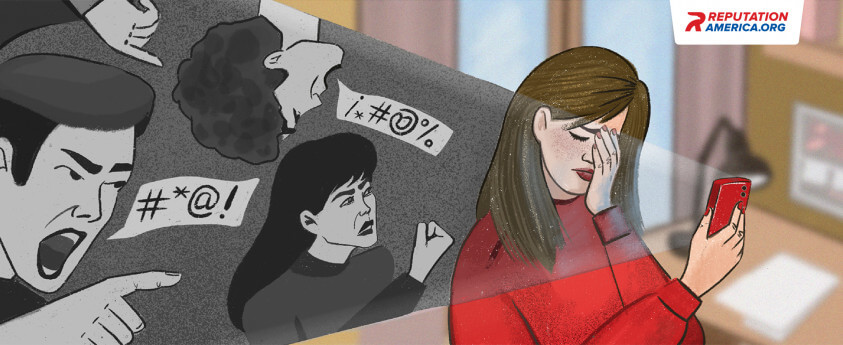Cyberbullying: How to Protect Yourself from Abuse

We have made it clear about the cyberbullying phenomenon and collected useful cyberbullying advice on fighting it.
Strangers are writing nasty things on a social network and spamming insults on Facebook. Who are they and why this baseless hatred? And, what’s more important – how do you combat them?
Offending a person is easy, and it is even easier on the Internet. No one is immune to anonymous rage. Strangers direct their fire on school children, politicians, and celebrities with equal facilities.
Table of contents

We will help you to improve your personal reputation
It’s free, confidential, and without obligation
Cyberbullying: what is it
Do you know the word “bully”? This is what schools call problem children and teenagers. They start fights, prefer to solve problems by resorting to violence, and don’t obey adults. The “bullies” believe that the strongest are in the right. They refuse other criteria. Cyberbullying is a substitute for such behavior on the Internet.

The first cyberbullying case took place in 1998 in the United States. At that time, the Internet was young and not as developed as it is today. But it was enough to destroy the reputation of a young White House trainee, Monica Lewinsky. Mass media and the public were discussing the scandal around her sexual relationship with the US President Bill Clinton. At the same time, Monica Lewinsky’s mail was flooded with letters containing threats and mockery, and bullies kept calling her friends and spreading new rumors. The next time the woman appeared in public was at the TED conference in 2015, where she spoke about her experience in combating bullying.

Today, the most common cyberbullying victims are children and teenagers. An adult is also at risk of becoming a target, but there are other terms for this. Cyberharassment is an international phenomenon.
The main difference between cyberbullying and other types of aggression is anonymity. Bullies hide under nicknames or other people’s names. They may know the victim first-hand or act on a tip just for fun.
Cyberbullying is a deliberate humiliation of a person, no matter what for. There may be any reason for cyberharassment: being a high achiever, or looking different, or having an unusual hairstyle.
Cyberbullying is a teenage problem
Most of a child’s life is somehow related to the Internet and mobile devices. The virtual world is seen as a natural continuation of the real one. Therefore, it is important for a child to feel safe in cyberspace.
Children and teenagers have a hard time experiencing cyberharassment. Stress may result in depression, lower self-esteem and other disorders. Teenagers have no developed self-defense mechanisms; they can’t yet separate themselves from the surrounding events.
Possible signs of cyberbullying
A drastic change in a child’s behavior doesn’t necessarily indicate cyberbullying. There may be other problems. However, parents and relatives should pay attention to the following signs:
- The child’s mood has changed. He or she is sad for no apparent reason, uses the phone and computer less than usual, avoids peers or tries to go online less often.
- The child seems strained or scared, is afraid to go to school or attend a favorite hobby group, worries when hearing mobile phone signals, or may ignore phone calls.
- Changes in online communication. The child has closed their page or deleted their social network account.
Every parent doesn’t expect that from their child, but you should also pay attention to these signs, which may indicate that your child is a “bully”:
- The child is very secretive. He tries to hide the screens of his gadgets from you.
- Impersonation. Has several accounts on the network or uses someone else’s.
- Behavior. You are often called to school because of your child’s behavior, or your child is often complained about.
- Status. Your child is very worried about his value, popularity, and social status.
Of course, all these signs could indicate a number of other things. But according to cyberbullying.org, from 71% to 74% of children have experienced cyberbullying in their lifetime. The best way is to talk to your child about why people bully others. It is important for the child to understand that there is nothing wrong with him. The child doesn’t need to change his look or opinions, or adapt to the imposed standards. You shouldn’t sound unapproving, but show your support.
It is not enough to follow the children’s pages. It’s better to “make friends” and follow updates. 26% of parents learned about their child being bullied later than their friends and school teachers.
Cyberbullying: how to stop it
Take care of this in advance and use preventive protection.
Restrict information on a social network. Cyberbullying goes beyond aggression on social networks. Trolls send SMSs and continue bullying in messenger systems and online games. Any personal data is a real catch for the aggressor. It makes it easier to reach the victim.
What to do: restrict some of your personal information on social networks. Make it visible only to your friends.
Configure your privacy. Social networks make it possible to restrict access to your page: prohibit adding tags to photos or commenting posts on the wall, or block certain people.
If the bullies have initiated the aggression, remember this simple cyberbullying advice:
- Complain to the administration. It is in the social network’s interest to maintain a friendly atmosphere. Therefore, they promptly respond to complaints about any cases of aggressive behavior. There are similar systems in Messenger and online games.
- Do not react. The bully’s purpose is to make the victim react. Thus, they will understand that they have hit the target and will keep going. The lack of reaction will demonstrate that they will have to spend more effort on the victim.
- Amass evidence of bullying. Anything will do: SMSs, screenshots of dialogs, and received doctored pictures. If the cyberharassment continues, send the material to the police.
- Block the abuser. Remove him or her from your friends’ list, address, and phone books, or add them to the blacklist.
- Attract adults. This can be not only your parents, but also other members of your family or your teacher. Any adult you trust.
We have collected information and useful tips about cyberbullying for you, but this may not be enough to solve your problem. You can also go to and refer to sites such as cyberbullying.org or stopbullying.gov that specialize in dealing with these situations. Of course, we will always answer all your questions about cyberbullying and help you stop or avoid it.







This article does not have any comments. Be first to leave one.